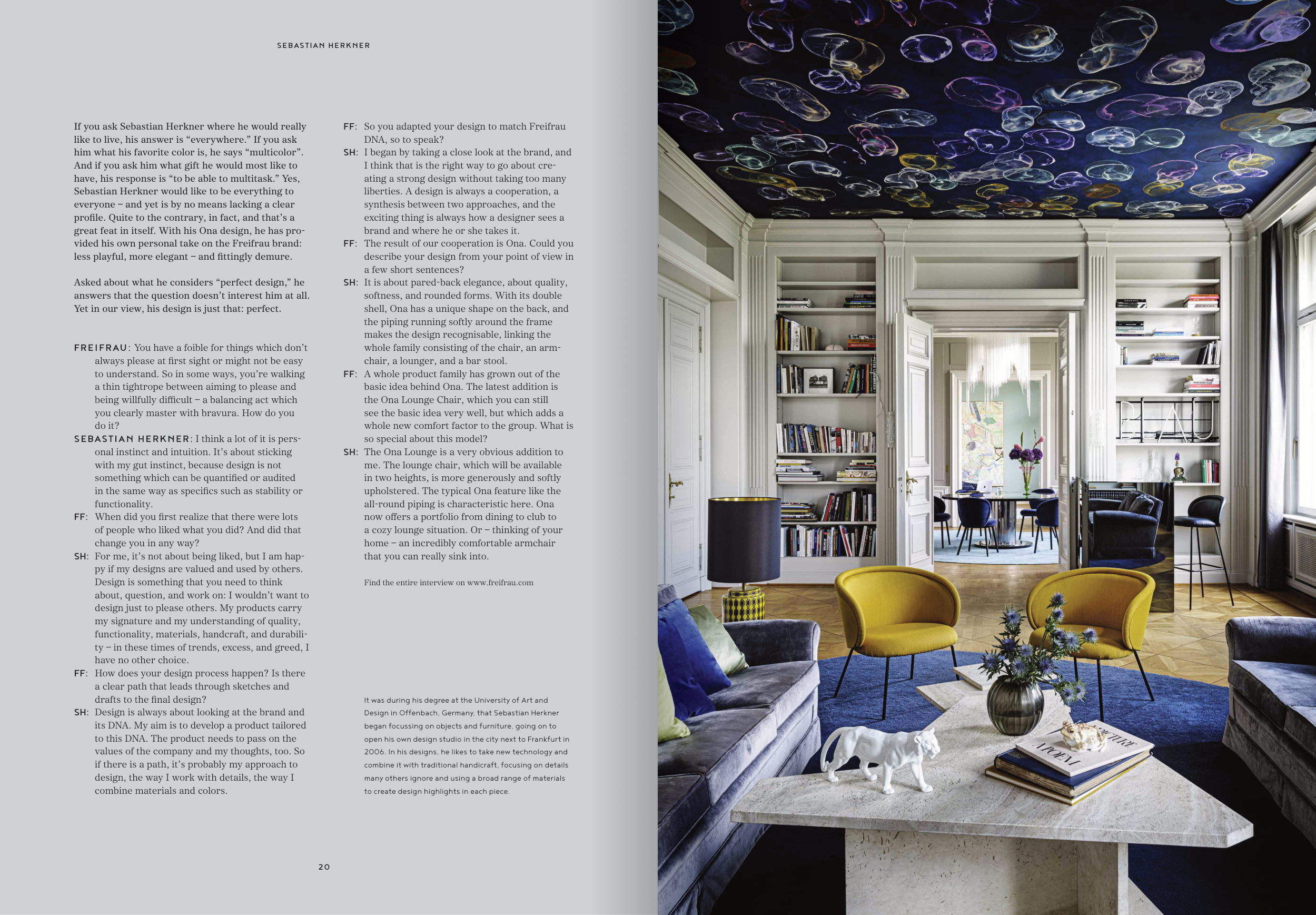20
21
If you ask Sebastian Herkner where he would really
like to live, his answer is “everywhere.” If you ask
him what his favorite color is, he says “multicolor”.
And if you ask him what gift he would most like to
have, his response is “to be able to multitask.” Yes,
Sebastian Herkner would like to be everything to
everyone – and yet is by no means lacking a clear
profile. Quite to the contrary, in fact, and that’s a
great feat in itself. With his Ona design, he has pro-
vided his own personal take on the Freifrau brand:
less playful, more elegant – and fittingly demure.
Asked about what he considers “perfect design,” he
answers that the question doesn’t interest him at all.
Yet in our view, his design is just that: perfect.
FREIFRAU: You have a foible for things which don’t
always please at first sight or might not be easy
to understand. So in some ways, you’re walking
a thin tightrope between aiming to please and
being willfully difficult – a balancing act which
you clearly master with bravura. How do you
do it?
SEBASTIAN HERKNER: I think a lot of it is pers-
onal instinct and intuition. It’s about sticking
with my gut instinct, because design is not
something which can be quantified or audited
in the same way as specifics such as stability or
functionality.
FF: When did you first realize that there were lots
of people who liked what you did? And did that
change you in any way?
SH: For me, it’s not about being liked, but I am hap-
py if my designs are valued and used by others.
Design is something that you need to think
about, question, and work on: I wouldn’t want to
design just to please others. My products carry
my signature and my understanding of quality,
functionality, materials, handcraft, and durabili-
ty – in these times of trends, excess, and greed, I
have no other choice.
FF: How does your design process happen? Is there
a clear path that leads through sketches and
drafts to the final design?
SH: Design is always about looking at the brand and
its DNA. My aim is to develop a product tailored
to this DNA. The product needs to pass on the
values of the company and my thoughts, too. So
if there is a path, it’s probably my approach to
design, the way I work with details, the way I
combine materials and colors.
FF: So you adapted your design to match Freifrau
DNA, so to speak?
SH: I began by taking a close look at the brand, and
I think that is the right way to go about cre-
ating a strong design without taking too many
liberties. A design is always a cooperation, a
synthesis between two approaches, and the
exciting thing is always how a designer sees a
brand and where he or she takes it.
FF: The result of our cooperation is Ona. Could you
describe your design from your point of view in
a few short sentences?
SH: It is about pared-back elegance, about quality,
softness, and rounded forms. With its double
shell, Ona has a unique shape on the back, and
the piping running softly around the frame
makes the design recognisable, linking the
whole family consisting of the chair, an arm-
chair, a lounger, and a bar stool.
FF: A whole product family has grown out of the
basic idea behind Ona. The latest addition is
the Ona Lounge Chair, which you can still
see the basic idea very well, but which adds a
whole new comfort factor to the group. What is
so special about this model?
SH: The Ona Lounge is a very obvious addition to
me. The lounge chair, which will be available
in two heights, is more generously and softly
upholstered. The typical Ona feature like the
all-round piping is characteristic here. Ona
now offers a portfolio from dining to club to
a cozy lounge situation. Or – thinking of your
home – an incredibly comfortable armchair
that you can really sink into.
Find the entire interview on www.freifrau.com
It was during his degree at the University of Art and
Design in Offen bach, Germany, that Sebastian Herkner
began focussing on objects and furniture, going on to
open his own design studio in the city next to Frankfurt in
2006. In his designs, he likes to take new technology and
combine it with traditional handicraft, focusing on details
many others ignore and using a broad range of materials
to create design highlights in each piece.
SEBASTIAN HERKNER


